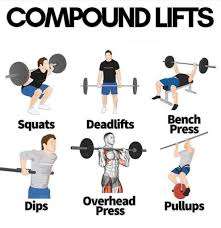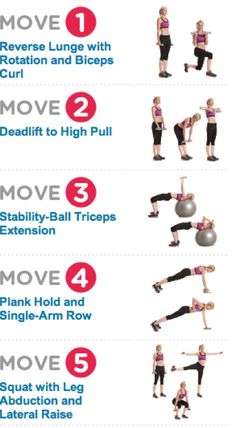When it comes to fat loss, many of us default to hours of cardio or low-calorie diets.
But what if the secret to torching fat faster was trading that treadmill for a barbell?
Compound lifts—those big, multi-joint movements that recruit several muscle groups at once—are the unsung heroes of weight loss.
They are not just for building muscle; they are also incredibly effective for melting away fat.
In this article, LeanAndFit research team shall explore how compound lifts accelerate fat burning.
We’ll dive into the science of energy expenditure, hormonal benefits, and why these movements outshine isolation exercises.
Whether you are new to lifting or an experienced gym-goer, you’ll see how incorporating compound lifts into your routine can transform your fat-loss journey.
Article Contents:
- What Are Compound Lifts?
- How Compound Lifts Burn More Calories
- The Hormonal Boost from Compound Movements
- Why Compound Lifts Boost Afterburn (EPOC)
- Best Compound Movements for Weight Loss
- FAQs on Compound Lifts for Fat Burning
- Real-Life Example: Jake’s Fat-Burning Journey
- Scientific Studies Supporting Compound Weight Training for Fat Loss
- The Long-Term Benefits of Compound Workouts
- Conclusion: Why Compound Lifts Are Essential for Fat Loss
What Are Compound Lifts?
Compound lifts are exercises that engage multiple muscle groups and involve movement at more than one joint.
Think of moves like squats, deadlifts, bench presses, pull-ups, and overhead presses.
Unlike isolation exercises (such as bicep curls or leg extensions), compound lifts work several muscles simultaneously, making them more efficient for building strength and burning calories.
But these are not just about lifting heavy for the sake of it—compound lifts for fat loss are particularly effective because they require your body to work harder, boosting calorie burn during and after your workout.
How Compound Lifts Burn More Calories?
When you perform a compound movement like a squat, you are not just engaging your quadriceps; your hamstrings, glutes, core, and even your upper body are pitching in.
The more muscles you recruit, the more energy your body uses.
The Science of Calorie Burn:
According to a study published in Medicine & Science in Sports & Exercise (2017), multi-joint exercises like deadlifts and squats significantly increase caloric expenditure compared to single-joint exercises.
Compound lifts are demanding, meaning your body burns more calories both during the workout and as it recovers afterward.
Consider this: A compound workout routine for fat loss does not just torch calories in the gym—it keeps your metabolism elevated for hours post-exercise.
The Hormonal Boost from Compound Movements
Compound movements for weight loss do not just burn calories—they also trigger a hormonal response that helps you shed fat.
Testosterone and Growth Hormone
Heavy compound lifts for fat loss stimulate the release of testosterone and growth hormone, two key players in muscle building and fat loss. Testosterone aids in preserving lean muscle mass while burning fat, and growth hormone increases the body’s ability to use fat for fuel.
A study in the Journal of Strength and Conditioning Research (2016) showed that participants performing compound lifts experienced higher testosterone and growth hormone levels than those doing isolation exercises.
This hormonal boost is a game-changer for accelerating fat loss.
Why Compound Lifts Boost Afterburn (EPOC)?
Ever heard of EPOC, or excess post-exercise oxygen consumption?
It is the scientific term for what fitness enthusiasts call the “afterburn” effect—a phenomenon where your body continues to burn calories long after you’ve left the gym.
Essentially, your metabolism stays revved up as your body works to recover from the intense effort of your workout.
How It Works?
Compound weight training for fat loss is particularly effective at creating this afterburn effect.
Why?
Because exercises like squats and deadlifts recruit multiple muscle groups, placing a high demand on your body’s energy systems.
This level of effort requires extra oxygen during recovery, which translates to increased calorie burn even hours—or up to 48 hours—after your workout ends.
Think of it this way: while steady-state cardio burns calories during your workout, the calorie burn stops almost immediately after you are done.
Compound lifts, on the other hand, keep the furnace running, allowing you to burn fat while you are back at your desk, relaxing at home, or even binge-watching your favorite series.
A study published in The Journal of Applied Physiology (2015) found that compound lifts elevate EPOC levels significantly more than traditional cardio workouts, making them a superior choice for maximizing fat loss.
The takeaway?
Compound lifts not only work harder during your session but keep working for you long after you leave the gym.
Best Compound Movements for Weight Loss
Not all exercises are created equal, especially when it comes to torching fat.
Compound movements stand out as the ultimate calorie burners because they recruit multiple muscle groups, making your body work harder.
Here are the best compound movements for weight loss and why they should be in your routine:

Squats
Squats are a powerhouse exercise, engaging your quads, glutes, hamstrings, and core all at once.
This multi-muscle engagement elevates your heart rate and turns squats into both a strength-building and fat-burning exercise.
Whether you are using body weight or adding a barbell, squats are non-negotiable for serious results.
Deadlifts:
Deadlifts are the king of full-body movements.
They strengthen your posterior chain—glutes, hamstrings, and lower back—while also activating your upper body.
The sheer energy demand makes deadlifts one of the most effective compound weight training exercises for fat loss.
Bench Press:
While typically associated with building a strong chest, the bench press also targets shoulders and triceps.
This upper-body compound lift not only builds strength but also boosts calorie burn when incorporated into a full workout.
Pull-Ups:
Pull-ups are a back and arm scorcher.
This bodyweight compound exercise is a fat-burning favorite, requiring serious effort to lift your entire body.
Overhead Press:
The overhead press strengthens your shoulders and core, challenging your stability while burning calories.
Adding these exercises to your compound workout routine for fat loss ensures faster, more sustainable results compared to isolation exercises.
These are your secret weapons for effective weight loss.
FAQs on Compound Lifts for Fat Burning
Q-1: What subtle signs show peer pressure is steering my food choices?
A-1: Watch for auto-pilot “yeses”—you match others’ portions without checking hunger, add sides because friends do, or say “I’ll have what they’re having” to end decision stress. Notice if you eat faster in groups, feel awkward being the only one without a drink/dessert, or keep snacks on your desk because “everyone else does.” If your order changes depending on who arrives, that’s a strong peer-influence signal.
Q-2: How can I tell if group norms—not hunger—are driving overeating at social events?
A-2: Do a quick pre/post check: before the event, write what you plan to eat; after, compare with what happened. If deviations cluster around rounds (refills, shared plates, desserts “for the table”), it’s a norm effect. Another tell: you stop when others stop, not when comfortably full. If you’d choose differently eating alone, you were likely following the group script.
Q-3: What workplace cues push me toward high-calorie grazing without noticing?
A-3: Free-food emails, “celebration” cakes, and standing meetings with pastries normalize constant snacking. If treats live in visible, high-traffic spots, you’ll “decide” multiple times daily. Peer prompts sound like “Grab one—big day!” or “Don’t be that person.” Track a week of office snacks: if most were unplanned or eaten while talking, peer context—not appetite—was in charge.
Q-4: How do friends’ ordering styles shape my portions and drink choices?
A-4: We mirror the first confident order. When someone declares “Let’s do appetizers and dessert,” the table’s anchor shifts up; when a peer opens with a balanced entrée and water, the anchor shifts down. If you routinely upsize when a specific friend leads, that friend is your “portion pacer.” Counter by offering to order first with a plan you’re happy to repeat.
Q-5: What practical tests reveal whether peer pressure is adding calories that lead to weight gain?
A-5: Run two A/B experiments for two weeks each:
-
Order-First Test: You go first with a pre-chosen meal vs. you go last and match the group. Compare fullness and energy later.
-
Pre-Commit Test: Message the group your plan (entrée + side salad; skipping dessert) vs. decide at the table. Track extra items added.
If the “match-the-group” weeks consistently add sides, rounds, or desserts, peer pressure is a measurable driver. Use tiny scripts—“I’m good with this,” “I’ll start”—and seat cues (sit farthest from shared plates) to keep choices yours.
>>> Click Here to Learn How I “Accelerated My Fat Loss” by Combining Compound Lifts with “Delicious Smoothies” <<<
Jake’s Fat-Burning Journey
Scientific Studies Supporting Compound Weight Training for Fat Loss
The science behind compound movements for weight loss is compelling:
- “Caloric Expenditure in Multi-Joint vs. Single-Joint Exercises” (Medicine & Science in Sports & Exercise, 2017): Demonstrated that compound lifts burn significantly more calories than isolation exercises.
- “Hormonal Response to Resistance Training” (Journal of Strength and Conditioning Research, 2016): Found that compound lifts boost testosterone and growth hormone levels, aiding fat loss.
- “EPOC and Resistance Training” (Journal of Applied Physiology, 2015): Showed that compound lifts create a higher afterburn effect compared to steady-state cardio.
- “Metabolic Effects of Resistance Training” (Sports Medicine, 2018): Highlighted how compound lifts improve overall metabolism, increasing fat-burning potential.
These studies underline why compound weight training for fat loss is more effective than other forms of exercise.

The Long-Term Benefits of Compound Workouts
Compound workouts are not just a quick fix for shedding pounds—they offer long-lasting benefits that make fat loss sustainable and effective.
By building strength, improving metabolism, and enhancing functional fitness, these exercises go far beyond just burning calories in the gym.
Increased Lean Muscle Mass:
One of the most significant advantages of compound lifts is their ability to build lean muscle.
Exercises like squats and deadlifts engage multiple muscle groups simultaneously, promoting overall muscle growth.
More muscle mass means a higher resting metabolic rate, allowing your body to burn more calories even when you are lounging on the couch.
This metabolic boost makes long-term weight loss not only achievable but maintainable.
Improved Functional Fitness:
Compound lifts mimic movements you perform in daily life—picking up heavy objects, climbing stairs, or even getting out of a chair.
By strengthening multiple muscle groups at once, these exercises enhance your functional fitness, making everyday tasks easier and reducing the risk of injury.
Consistency and Enjoyment:
Let’s face it: repetitive cardio sessions can feel like a chore.
Compound workouts, on the other hand, are dynamic and challenging.
Whether it is perfecting your form on a deadlift or setting a new personal best on squats, the variety and intensity keep you engaged.
This makes it easier to stay consistent with your fitness routine, a key factor for sustained fat loss.
Incorporating compound workouts into your routine transforms fitness from a temporary fix into a sustainable lifestyle.
Why Compound Lifts Are Essential for Fat Loss?
When it comes to fat loss, compound lifts are the ultimate game-changer.
They burn more calories, trigger a powerful hormonal response, and keep your metabolism elevated long after your workout is over.
Whether you are doing squats, deadlifts, or pull-ups, these exercises regimes pack a fat-burning punch that no isolation exercise can match.
So, if you are serious about shedding fat and transforming your body, it is time to embrace the power of compound movements.
Not only will they help you burn fat faster, but they will also improve your overall strength, functionality, and fitness in ways you never thought possible.
References:
